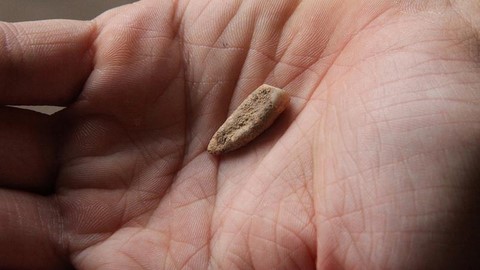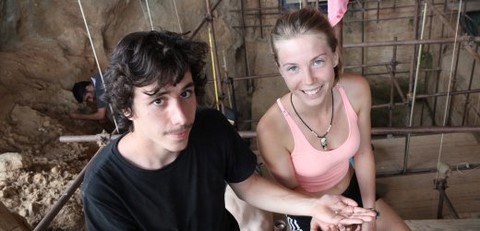550,000 year old human tooth found at Tautavel, France
Older by 100,000 years than Tautavel Man

A 550.000 year old human tooth has been discovered on the famous prehistoric site of Tautavel, a cave perched hich above the gorges of the Verdouble river, 35 km NW of Perpignan, in the Eastern Pyrénées of France. If its age is confirmed, it will be one of the oldest human fossils to be found in France, sharing the honor with a canine of the same age which was found in the Aven of Vergranne, in the department of Doubs, in the French Jura.
"A big adult tooth – of a man or woman, it cannot be said – has been found during the excavations in a level of soil which we know goes back 550,000 years, for many methods of dating have been used on it ", explained paleontologist Amélie Viallet. "It’s a major discovery, because we have very few human fossils going back to that period in Europe».
"It’s one of the missing pieces of the jigsaw contributing to answer the crucial question : did Neanderthal man, 120,000 years ago, come from one single hominid line ? » added the paleoanthropologist, who works at the research center at Tautavel and is also a senior lecturer at Museum of Natural History in Paris.
The Caune (Catalan word for cave) de l’Arago where the precious « central inferior inciser » has been found, is an exceptional deposit. For nearly half a century, thousands of remains have been discovered there, which have been dated from 80,000 to 550,000 years. The tooth constitutes the 149th remain of a hominid discovered in this cavity which was occupied for over 600,000 years, that is, for a large part of the middle Pleistocene (781,000 to 126,000 years). Over 600,000 objects from deposits dated between 80 000 to 560 000 years, have been found in the Caune, spread over the various climatic variations of this period of the Quaternary.
Among the humain remains recovered since 1971 by the prehistorian Henry de Lumley and his team, there figures in particular one famous skull, designated asTautavel Man (450,000 ans), bearing witness to the oldest presence of hominids in France (Pre-Neanderthals or Homo heidelbergensis). This newly discovered adult human tooth (older by 100.000 years than the illustrious Tautavel skull itself), was found in the most ancient levels being excavated this year, corresponding to a cold, dry and windy period, going back about 560,000 years, during which Acheulean hunters abandoned on the floor of the cave leftovers from their meals, composed of horses, reindeer, bisons, rhinoceros, mouflons... These levels are full of disarticulated and fractured animal bones and of stone tools left behind. The Tautavel Man remains had been found on levels higher up, notably on level D, dated 450,000 years, also corresponding to a steppe landscape, but one of an ealier glacial episode.
With the exception of the Mauer mandible, discovered in 1907 in Germany and dated at around 600,000 ans, there are very few human fossils known in Europe for the period. The tooth discovered on July 23rd, 2015, is much worn, and it will allow the researchers at the European Center of Prehistoric Research at Tautavel, by studying its internal characteristics by means of 3D imaging, to better make out the morphology of the first inhabitants of Europe. Moreover, its presence in an exceptionally rich level of occupation, lets one hope that more discoveries may be in the offing.
The sensational find was made by two young French volunteers, Camille Jacquey (16), and Valentin Loescher (20), who were going painstakingly with small brushes over an excavation square. During the 50 years since it's discovery, thousands of volunteers from all over the globe have come to work on the site. This summer’s campaign of excavations is in full swing and could well yield another surprise, or two...

Valentin Loescher (20) and Camille Jacquey (16), the two volunteers who found the tooth.
Translated and adapted by Anne-Marie de Grazia from the article by Bernadette Arnaud in "Science et Avenir" an article in "Le Figaro" (interview of Amélie Viallet), both of July 28th, 2015, and the website Hominides.

